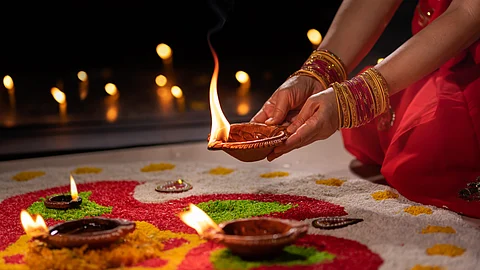
- Destinations
- Experiences
- Stay
- What's new
- Celebrating People
- Responsible Tourism
- CampaignsCampaigns
- SubscribeSubscribe
- Buy Now

Diwali, the festival of lights, is one of the most significant occasions amongst Indians. It symbolises the victory of light over darkness, good over evil, and knowledge over ignorance. However, how Diwali is celebrated varies across different regions of the country. Each region has its own unique traditions and practices that show their distinct culture, so much so that you can take a look at the tradition and tell which place it comes from. Here are seven examples of how Diwali is celebrated differently in different parts of India.
Did you know that Diwali coincides with Kali Puja or Shyama Puja? It's a festival dedicated to the fierce goddess Kali, believed to be the destroyer of evil and the protector of her devotees. On this auspicious night, Bengalis perform elaborate rituals, make offerings, and even sacrifices to show their devotion to Kali. People also light lamps and candles to illuminate the night and ward off negative energies in West Bengal.
This holy city on the banks of the Ganges celebrates Diwali in a grand manner. Dev Deepawali means the festival of lights of the gods. It is believed that on this day, the gods descend to earth and bathe in the Ganges. To welcome them, people decorate the ghats with earthen lamps and flowers. They also perform Ganga Aarti, a ceremonial worship of the river, and enjoy fireworks and cultural programs on the ghats of Varanasi.
Diwali in Odisha involves a unique ritual called Kauriya Kathi, which means burning jute sticks. People light bundles of jute sticks and chant mantras to guide the souls of their ancestors to heaven. They also believe that by doing this, they will invoke the blessings of their forefathers and ensure prosperity for their families.
In Maharashtra, Diwali commences with Vasu Baras, which means cow worship day. Cows are considered sacred in Hinduism and symbolise motherhood. On this day, people honour cows by washing them, feeding them, and decorating them with flowers and colours. They also exchange sweets and gifts with their neighbours and friends.
In Gujarat, Diwali marks the beginning of a new year, according to the Vikram Samvat calendar. People celebrate this occasion by cleaning their houses, making colourful rangoli designs on the floor, lighting lamps and candles, and offering prayers to Lakshmi, the goddess of wealth. They also visit temples, exchange greetings and sweets with their relatives and friends, and enjoy gambling games.
In Goa, Diwali involves the burning of Narakasura effigies, which symbolise the victory of good over evil. Narakasura was a demon king who terrorised the people and was killed by Lord Krishna on this day. People make huge effigies of Narakasura using paper, cloth, straw, and firecrackers. They parade them on the streets and burn them at dawn.
In Punjab, Diwali coincides with Bandi Chhor Divas, which means the day of liberation. It commemorates the release of Guru Hargobind Singh, the sixth Sikh guru, from prison along with 52 other kings who were held captive by the Mughal emperor Jahangir. On this day, people light lamps and candles in their homes and gurdwaras (Sikh places of worship). They also sing hymns, recite scriptures, and share langar (community meal).
